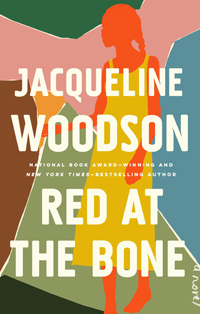 Jacqueline Woodson, Red at the Bone: A Novel (New York: Riverhead Books, 2019), 196pp.
Jacqueline Woodson, Red at the Bone: A Novel (New York: Riverhead Books, 2019), 196pp.
Jacqueline Woodson (born 1963), winner of the Newberry Medal, the National Book Award, and numerous other awards for her thirty books, once said that she wanted "to write about communities that were familiar to me and people that were familiar to me. I wanted to write about communities of color. I wanted to write about girls. I wanted to write about friendship and all of these things that I felt like were missing in a lot of the books that I read as a child." That's what she did in her last novel Another Brooklyn (2016), and what she does once again in Red at the Bone. Both stories are set in Brooklyn, where Woodson has spent most of her life.
At a simple level, this story is about an unplanned teenage pregnancy. Iris and Aubrey were only tenth-graders when their baby Melody was born. The neighbors gossiped. The Catholic church expelled Iris from parochial school. The parents fretted. There were feelings of fear and shame all around. The familiar assurances of Christian faith felt besieged.
In Woodson's telling, this unremarkable event becomes understandably complex, just like real life, as she explores the impact of Melody's birth on the five central characters in the story, who come from three generations, and who each narrate parts of the novel. Red at the Bone is a coming of age story about love, sex, family, and gender identity, and in particular about what it's like to be an urban, black, teenage girl.
There are issues of class, as Iris comes from a family of silk stockings and a Brooklyn brownstone, whereas Aubrey comes from food stamps, fried bologna, and a single mother. Matters of race are also a major theme — hair texture, skin tone, eye color, music, food, and urban slang. Mother-daughter issues loom large — Melody refers to her mother Iris by her given name, not "Mommy," and laments that "somewhere along the way, I became your enemy." And all these complicated matters are interpreted through the filters of personal memory and multi-generational history.
The story begins in the ominous year of 2001, then moves forwards and backwards in time. The very first word of the novel is "but," a conjunction that signals contrast and even impossibility. Toward the end, when Iris has left Aubrey and Melody for college in Ohio, and found new love there, she says that she felt "red at the bone, like there was something inside of her undone and bleeding."
Dan Clendenin: dan@journeywithjesus.net


